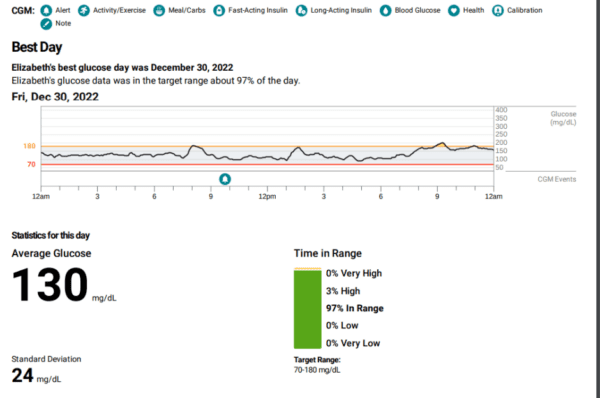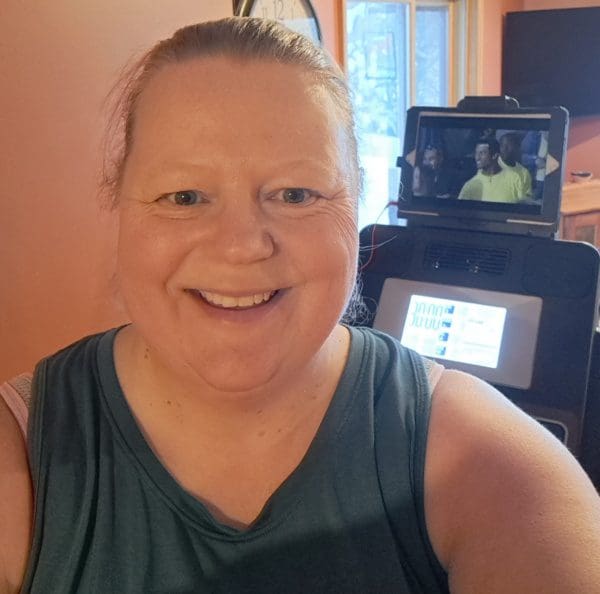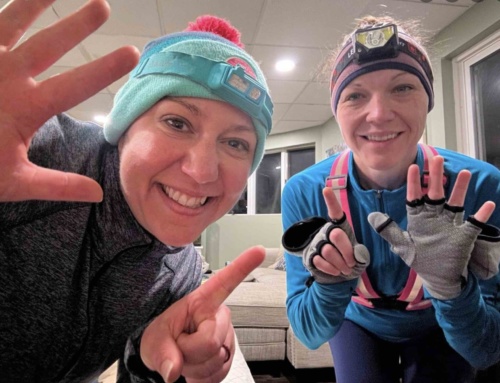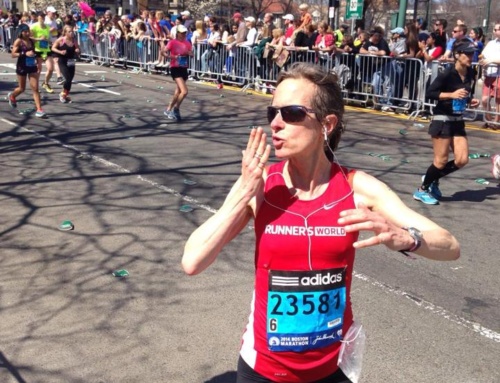My annual labs claim I’m healthy. Let’s be frank, though. I’ve struggled with PCOS symptoms for decades. And genetics aren’t in my favor; my father’s leg was amputated after a dime sized cut on the bottom of his foot refused to heal, despite months of wound care. Most recently, I watched my midsection balloon from a combination of pandemic pounds, perimenopause and a love for tortilla chips.
I’ve talked about how James Clear’s Atomic Habits has been a game changer in helping me change that trajectory in a way that finally feels sustainable. The scale is trending down while my exercise and muscle mass is trending up—all good things. That doesn’t mean I don’t want to arm myself with as much knowledge as possible, though. Enter continuous glucose monitoring or CGM.
As I set my 2023 intentions at the end of 2022, a half-marathon topped my list. My last attempt was canceled during the pandemic, then dad died and I gave myself grace to find joy in the run. I turned to 10Ks and 5Ks with friends but in the back of my head, the Sisu in me has unfinished business with the race where my running journey started. This May I’ll run the Madeline Island Half-Marathon.
I’ve reached a point in my running journey where it isn’t so much about a PR as joy. But I wanted to enter training with vibrancy and energy and the mindset to enjoy the 16-weeks of training (or as much as one can for someone who still doesn’t love running but loves calling themselves a runner).
Lately, a lot of ads about using a continuous glucose monitor (CGM) have been popping up in my feed. Generally, a CGM is used to manage Type 1 or Type 2 diabetes by providing continuous glucose or blood sugar level readings. But, there’s a growing number of companies who are also marketing these as a way for individuals to understand glycemic variability – or frankly what foods wreak havoc on your body and which ones will help you achieve optimal performance – both physically and mentally.
Previously, this was in the context of elite athletes. But, as someone who is continuously curious about understanding how my body works, I decided to give one a try since I’ve always struggled with proper fueling on my runs.
Since I have no medical diagnosis, I tried the CGM outside of my primary care provider. There are a number of services that offer this at a set fee that include a prescription from an independent physician and a consult with a registered dietitian afterwards. (PSA: If you are prediabetic or have any underlying conditions, talk to your PCP because there is a very good chance your insurance might cover this with a prescription and you should be consulting with your care team about long-term treatment.)
The process was painless and frankly fascinating. At times, borderline obsessive. After a quick prick to my stomach, a small canula attached to a sensor was inserted in my gut. Through a transmitter, attached to the sensor, I received real-time readings 24 hours a day for 14 days straight about my blood sugars. The interactive app allowed me to type what I was eating or doing before, during, and after a meal to give my dietitian insight into my blood sugar spikes. No surprise – the homemade pop tart and maple syrup latte treat meal I had while writing at a coffee shop was a poor life choice. Not as obvious? The need for me to eat a small protein packed snack before bedtime to help level my sugars out overnight.

A screen shot from the summary report of my CGM experiment.
It also turns out my predictably early lunch followed by a marathon sprint of afternoon meetings, child chasing, and late afternoon working-out on an empty stomach bottoms me out. It should seem obvious that this poor planning equates to me eating super-sized dinner portions, which leads to an unnecessary blood sugar drop and spike, but sometimes seeing is believing.
Perhaps most alarming, though, is the discovery that I’m hovering uncomfortably close to insulin resistance which could certainly lead to prediabetes without some lifestyle changes. I know white carbs are not my friends. I’ve viewed my A1Cs and my fasting blood sugars being in range as a pass before – but these real-time readings are hard to argue. I can and should be eating better if I want to defy the odds and not follow in the footsteps of my family’s genetics. This experiment caused me to slow down and see how individual choices impact my overall health. It made me want to do better – not only for my runs but for myself.

Spending lot of quality time this winter on my treadmill but Tim Riggins and Friday Night Lights makes it all better. Clear eyes, Full hearts, Can’t lose. Texas forever!
Since then, I’ve made a few minor tweaks to my eating. Nothing life changing – James Clear has drilled in my head that huge swings don’t work for me. Instead, little things. Remembering to eat a small afternoon snack. Drinking more water. Avoiding the homemade pop tart (but not the latte because some things in life are not worth giving up). Rethinking dinner portions. Paying attention to how I fuel up before I run. Nothing too restrictive but rather focused on adding the things my body is missing.
I’m still very early in my training. We’re in the heart of winter in Wisconsin so I’m dealing with treadmill hell and a lot of cross-training right now. But, I’m feeling Sisu strong going into this training cycle. Energized and excited about the next few months of implementing these few changes and seeing how it plays out on the road.






Great for you!
Wondering which CGM you used?